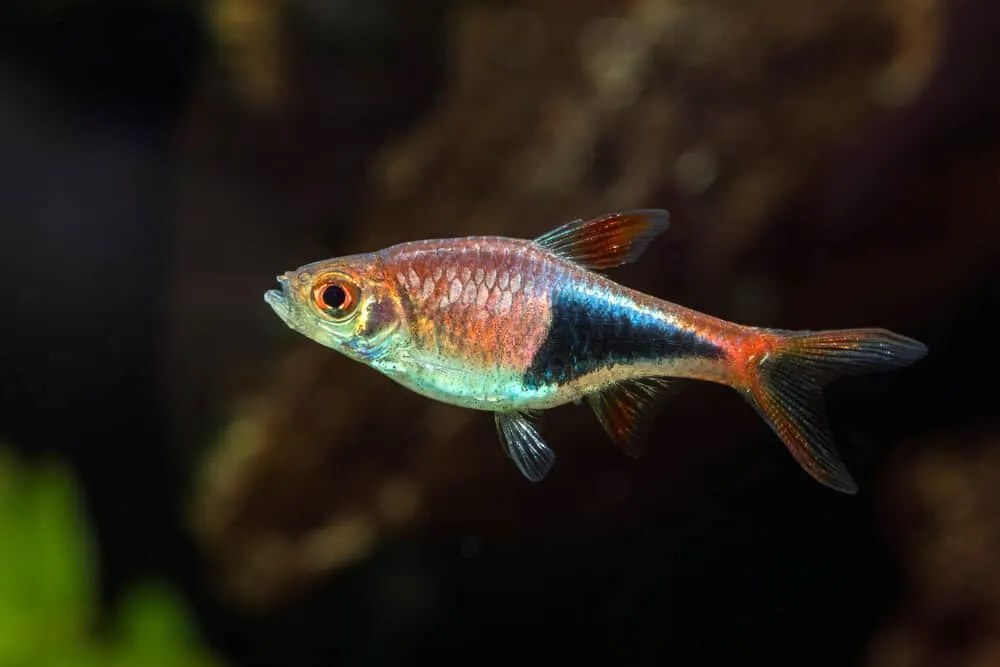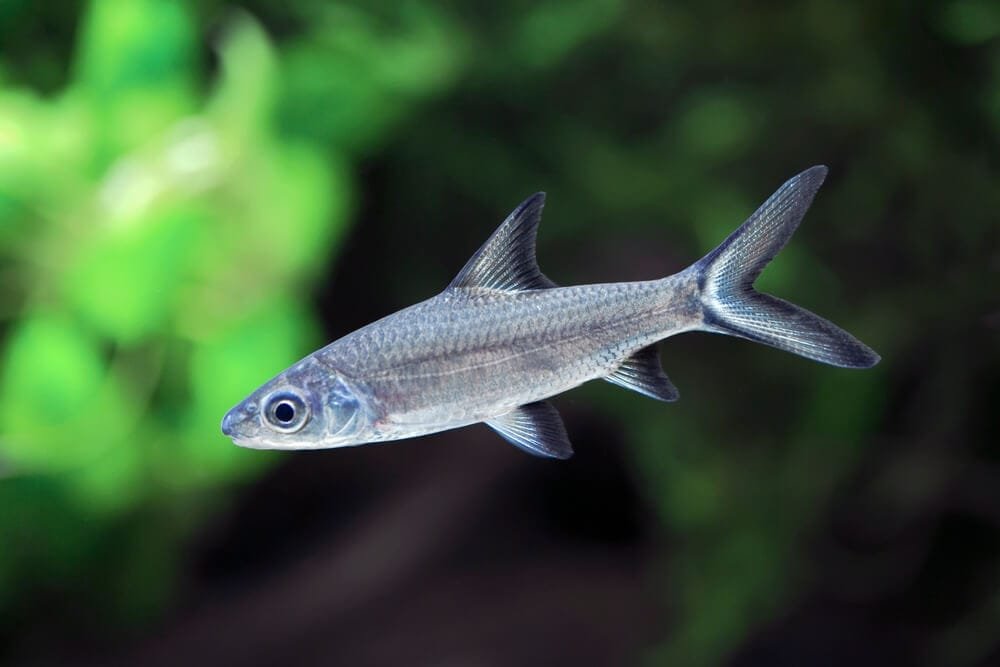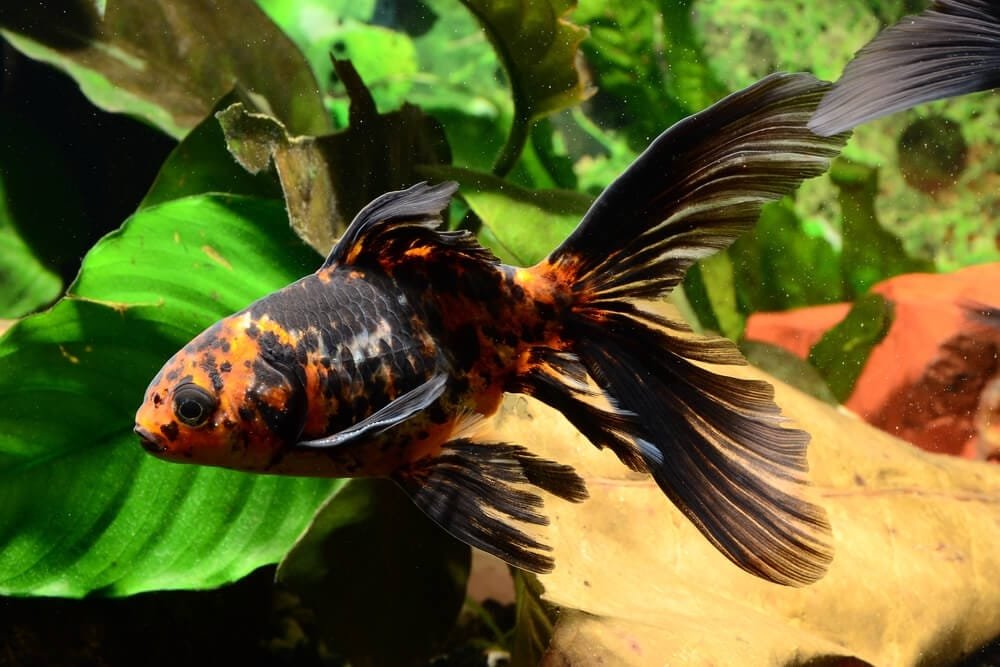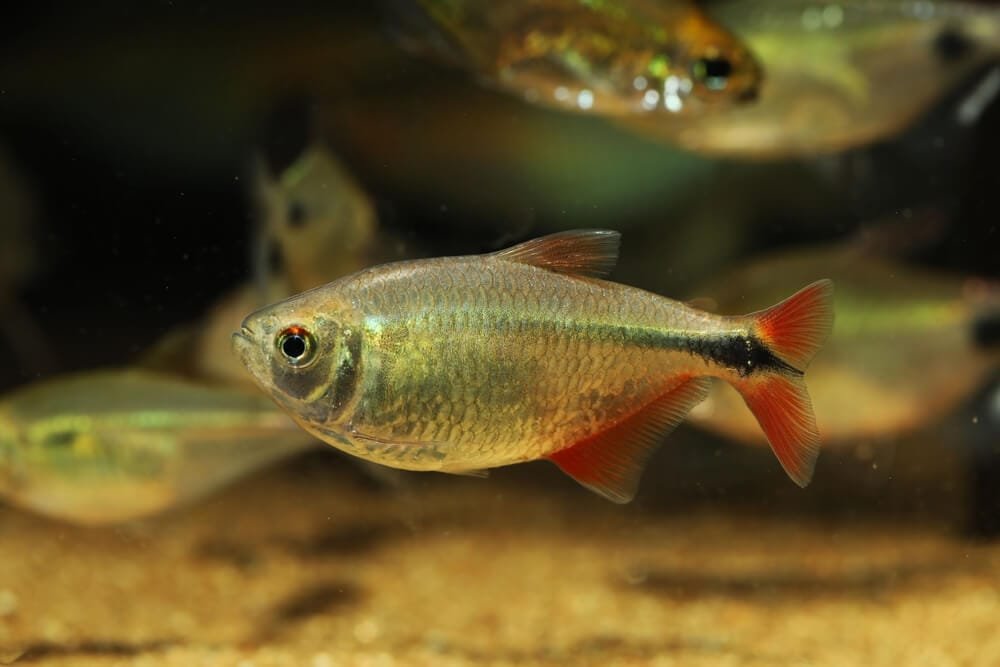Introduction
If you are thinking about housing Harlequin rasboras in an aquarium, then you must first know a few significant factors to consider when keeping these fish in captivity.
This in-depth guide will walk you through everything you need to know about Harlequin rasboras and how to properly keep them in a man-made habitat.
You will also learn how to properly breed these fish and take care of their offspring.
Additionally, we’ll go through other topics including proper diet, feeding, tank conditions, and compatible tank mates are also discussed in this guide.
Brief Overview Of Harlequin Rasbora
The Harlequin Rasbora is a freshwater fish originating from the family of Cyprinidae which is native to Singapore, southern Thailand, Malaysia, and Sumatra.
Their natural habitat consists of pristine, slow-moving soft water with very minimal acidity.
This fish comes with a pink or orange-colored variety that looks quite similar to glowlight rasbora and lambchop rasbora.
Due to their charming colors and features, Harlequin rasboras are a popular rasbora variety among many aquarists.
This fish also comes by the name Red Rasbora, Harlequin, and Harlequin Fish.
In the wild, this fish species inhabit heavily vegetated swamps and lush forest streams with gentle currents.
The fish can be found in many tanks around the world as they are quite popular among hobbyists. They are favored in the aquarium community because of their beautiful vibrant colors and schooling behavior.
Additionally, these fish require less maintenance making them suitable for beginners.
Overview Of Species And Characteristics
The Harlequin Rasbora’s scientific name is Trigonostigma heteromorpha. It is among the 50+ rasbora species known and also one of the most popular choices in the fishkeeping community.
Harlequins are fast-moving and highly agile fish. These fish are peaceful and have a calm temperament which makes them ideal tank mates for many other small, non-aggressive species.
This fish is a schooling type of fish so it is best to keep them in a group of at least 10 or more. Being in a group will help keep Harlequins feel comfortable and safe to swim around the aquarium.
Harlequin Rasboras cohabit well with most small, non-aggressive fish. However, some less agile fish may find Harlequin’s active lifestyle intrusive.
These fish spend most of their time in the middle area of the aquarium and they seldom explore the surface or the bottom.
They will hide among caves and plants in the tank whenever they feel stressed or if they are trying to get away with other tankmates.
Physical Characteristics
Out of the wide range of rasbora species out there, the Harlequin is definitely the most popular among aquarists.
Size And Shape
This fish is fairly small in size; it can grow about 1.75 inches to 2 inches long at most. However, Harlequins vary in appearance and size depending on their place of origin.
The ones from Thailand are typically smaller and more slender compared to the ones from Singapore. On the other hand, most female Harlequins are slightly thicker and larger than males regardless of their origin.
Colorings And Markings
Harlequins are often referred to as red rasbora due to their reddish-copper body color. They also have a visible accent of a black wedge that covers the rear end of their bodies.
Distinguishing Features
The Harlequin fish is distinguished by its noticeable triangular patch that begins around its dorsal fin and reaches a point close to its caudal fin base.
Habitat And Distribution
These freshwater species originated from Asian countries including Singapore, southern Thailand, Malaysia, and Sumatra in Indonesia.
Natural Habitat
In the wild, Harlequin rasboras inhabit lush forest swamps and streams with pristine and slow-moving water. This fish thrives in heavily vegetated areas with plenty of hiding spots from rocks and driftwood.
These fish’s natural habitat features soft and neutral water with very low acidity levels.
Moreover, because of the densely packed vegetation and the surrounding forest, Harlequin’s home in the wild is usually dimly-lit.
Range And Distribution
Harlequin rasboras are widely distributed in Peninsular Malaysia. This species has been collected in many areas in the country including Johor, Selangor, Pahang, Kelantan, and Terengganu.
In Singapore, Harlequins are often found in the swamp of Nee Soon – the last freshwater swamp in the island’s main catchment area.
Meanwhile, in Sumatra, the fish can be found on the Bintan island which is located in the province of Riau Islands.
Aquarium Requirements
In captivity, Harlequin rasboras are hardy and require minimal upkeep provided they are kept in a well-vegetated aquarium with optimum water parameter levels.
While it is true that Harlequins are suitable for beginner aquarists, there are a handful of things to keep in mind when keeping them in a tank.
Take note of these aquarium guidelines for keeping Harlequins. This will help them have the highest chances of survival in captivity.
Tank Size
When keeping Harlequin rasboras in an aquarium, make sure to add them to a tank that is at least 10 gallons in size. This size is suitable for a group of 6 individuals.
However, if you are planning to keep them in a larger group of about 10 to 15 individuals, a 20 to 30-gallon tank is a much better option.
This will provide them with enough space to roam around comfortably.
Remember that Harlequin rasboras are schooling fish; therefore, providing them with enough room to venture around is imperative.
Water Parameters
In the wild, Harlequins thrive on pristine freshwater swaps with soft and neutral water. Thus, when keeping them in an aquarium, using high-quality water has to be the top priority.
When keeping Harlequin rasboras in an aquarium, it is crucial that you replicate their natural habitat as much as possible. You can start by adding soft, neutral, and weakly acidic water to the tank.
Take note of these water parameters:
- Temperature: 74°F
- pH Level: 6.0 to 7.8
- Hardness: 2 to 15KH
To make sure your tank water’s optimum condition is kept, you can perform water tests regularly. Sudden changes in the water can stress out Harlequin fish and it may cause detrimental effects on their health.
Tank Decoration
As mentioned, the Harlequin rasboras’ natural habitat is densely vegetated. Thus, when keeping them in an aquarium, it is important to have a wide variety of aquatic plants where your fish can explore or hide.
You can include live plants such as Cryptocoryne or any other aquatic plant species with dense leaves.
Moreover, the natural home of Harlequins in the wild is dimly lit due to the lush surrounding forest and heavy vegetation. So adding some floating plant varieties is great for casting shadows inside the tank.
Substrate
The swamps and streams where Harlequin rasboras are naturally found have dark-colored riverbeds.
So in order to best imitate their natural home, you should add dark-colored gravel or sand substrate to the aquarium floor.
The sand substrate or gravel likely poses no harm to Harlequin fish as they rarely spend their time on the bottom of the tank.
Therefore, you don’t have to worry about the possibility of injuring your fish, especially from the gravel.
Behavior And Social Habits
Due to their calm temperament and peaceful nature, Harlequin rasboras are among the firm favorite tropical fish species among many in the aquarium community.
Schooling Behavior
Harlequin rasboras are schooling fish. In the wild, these fish swim in groups of hundreds to thousands of individuals.
When keeping Harlequins in an aquarium, it is extremely important to keep them in groups; ideally of 10 to 15 individuals. Being in a group will help keep these fish comfortable to roam around their environment.
Moreover, given that Harlequins are schooling fish, they must be provided with adequate space in the tank to freely swim around.
Aggression Levels
Harlequin fish are very peaceful and has a calm temperament. They typically cohabit well with other small, non-aggressive species in an aquarium tank.
They won’t be a bother to other species in the same tank as they don’t have any aggressive tendencies. They also will not nip on other fish’ fins or tails.
On the flip side, Harlequins are often subject to other species’ aggression. This may cause stress and make them reclusive.
Therefore, when keeping Harlequins in a tank, make sure to choose the right tank mates for them.
Compatibility With Other Species (Tank Mates)
When housing Harlequins in an aquarium, choosing the right tank mates for them is extremely important. Their tank mate is one of the top crucial factors that would affect their quality of life in captivity.
As Harlequins are fairly small, non-aggressive species, choosing tank mates with similar size, behavior, and temperament is a must.
That said, here are some of the best suitable tank companions for Harlequin rasboras:
Cardinal Tetras And Neon Tetras
Cardinal or neon tetras make great tank mates for Harlequin rasboras. These species are very similar in terms of size, behavior, and temperament.
Cardinal tetras and neon tetras only grow to about 1.5 Inches maximum in length. They are peaceful schooling fish that show no aggressive tendencies towards other fish.
On the same note, as cardinal tetras and neon tetras are schooling fish, it is recommended to house them in an aquarium in a group of at least 10.
Dwarf Gourami
The Dwarf gourami is another peaceful species that make a great tank companion for other non-aggressive fish such as Harlequins.
In fact, Dwarf gouramis are very peaceful and they allow themselves to be bullied by other fish.
Dwarf gouramis are slightly larger than Harlequins; they can grow to about three and a half inches in length.
However, dwarf gouramis pose no harm to other fish in the same aquarium as they are peaceful and timid at times.
Lastly, dwarf gouramis typically dwell in the bottom third part of the tank. This means they rarely come in contact with Harlequins which are normally middle dwellers.
Danios
Similar to Harlequin fish, Danios are small, peaceful, non-territorial species that make great tank mates for other fish with the same temperament and size range.
Although danios are very active, they don’t usually bother other fish and they will not cause any trouble.
Danios are schooling fish as well, and it is recommended to house them in a group of at least 6 individuals.
Apart from the fact that danios are calm and friendly, they also feature a wide range of vibrant colors making them the perfect addition to any aquarium.
Cory Catfish
The Cory Catfish, also known as Corydoras, is another species that make excellent tank mates for Harlequin rasboras. Similar to Harlequins, Cory catfish only grow to about 2.5 inches in terms of length.
Cory catfish are peaceful and non-aggressive and they will spend most of their time searching for food at the bottom part of the aquarium.
For these reasons, Cory catfish won’t cause any trouble nor harm your Harlequins.
Lastly, Cory catfish prefer to be kept in a group of at least six individuals.
Mollies
Mollies are fairly small fish that only grows up to about 3 inches in length. Just like Harlequin rasboras, mollies are peaceful with no aggressive tendencies.
Mollies are schooling fish and prefer to be kept in large groups. So if you are planning to house mollies and harlequins in one aquarium, make sure to use a larger tank; preferably 20 to 30 gallons.
Mollies thrive in well-vegetated environments, as are Harlequins. Thus, the two species make excellent tank companions.
Cherry Barbs
Unlike other species of the barb genus, Cherry barbs are not aggressive at all. These fish are fairly small in size and have a calm temperament.
Harlequin rasboras and Cherry barbs make great tank mates as both species are peaceful and non-territorial.
Similarly, both of them are schooling fish that prefer to be kept in groups. For Cherry barbs, housing a small group of at least five is recommended.
Aside from their non-aggressive nature, Cherry barbs are a firm favorite in the aquarium community due to their beautiful red color. Their vibrant shade and lively character will surely bring more spirit to any tank.
Hatchet Fish
Hatchetfish, specifically the Polyipnus Danae species, make great tank companions for Harlequin rasboras as they are a smaller variety that only grows up to about 1.2 inches in length.
When choosing hatchet fish, make sure to avoid the larger variety as they can be aggressive and territorial.
Polyipnus Danae hatchet fish, on the contrary, are peaceful and shy. These fish are natural bottom-dwellers, so they are less likely to interact with Harlequins.
Snails
Snails are generally great tank mates for a wide variety of species due to their peaceful nature. Additionally, they are less likely to become prey to other fish due to their protective shell armor.
Snails are scavengers – they will spend most of their time roaming around the aquarium searching for food such as algae and plant matter.
Aside from being able to live harmoniously with Harlequins and other species, snails can also help keep the aquarium clean and tidy.
Dwarf Shrimps
Dwarf shrimps are often on the receiving end of bullying and aggressiveness by other fish. They are typically very peaceful and shy, and they don’t like being a bother to other species in the same tank.
Harlequins and dwarf shrimps make excellent tank companions as they are both calm and non-aggressive in nature.
Some of the top dwarf shrimp varieties include Amano shrimp, Bamboo shrimp, Ghost shrimp, and Caridina shrimp.
Plecos
Plecos are a must for many aquarists because these species are known for keeping tanks clean and tidy. Aside from that, plecos are very peaceful and will not show any aggressive behavior towards other species.
Plecos are voracious scavengers that spend most of their time searching for algae and food scraps. They typically dwell at the bottom or attach themselves to any solid surfaces inside the aquarium.
Diet And Feeding
In this section, we’re going to focus more on the Harlequin fish’s proper diet and feeding.
Natural Diet
Harlequin rasboras are naturally omnivores but they also love consuming live foods. In the wild, they eat mosquito larvae, insect larvae, micro worms, zooplankton, and other very small invertebrates.
Feeding Habits In Captivity
As mentioned, Harlequins are omnivores that eat pretty much anything they can find in their habitat. They can be fed with high-quality commercial granules or flakes.
Harlequins are micro-carnivores too which means they also love feeding on live foods every once in a while.
You can supplement their diet by giving them freeze-dried or live worms, daphnia, and brine shrimp a couple of times per week.
Recommended Food Types
Given that Harlequin fish are very small and have tiny mouths, you must provide them with commercial fish foods that are small enough for them to eat easily.
On the other hand, because Harleyquins also like live foods, you can feed them with tiny life food varieties such as daphnia and tubifex worms.
Breeding
Reproduction In The Wild
Harlequin rasboras that have reached their sexual maturity usually mate by swimming together. They eventually move under any suitable plant with a broad leaf where they deposit the eggs.
Breeding In Captivity
Breeding Harlequins in captivity is no easy task. In fact, many aquarists do not even give breeding this species a second thought because of how challenging it is.
The main reason why Harlequin fish are extremely difficult to breed is due to their very specific water parameter requirements.
Here are a few conditions to meet in order to increase the chances of successful breeding of Harlequin fish:
- The fish to breed must be kept in a separate tank.
- The tank must be well-vegetated with plants with broad leaves as these will serve as breeding spots for the fish. The female fish also deposits its eggs on the rear side of the leaves.
- Although most aquatic plants work fine, many aquarists and breeders have reported better success with Aponogetonplants and Cryptocoryne.
- The tank must have soft water with a minimum acidity level. In the wild, the swamps and streams’ soft water have shown to have a significant impact on the eggs’ fertility.
- Temperature also plays a vital role in the success of the breeding process. Ideally, the water temperature for breeding Harlequins must be around 82.5°F.
Once all of these steps are done and the said conditions are met, the next integral step is to get the Harlequins into mating conditions. You can achieve this by feeding the fish with flake food and frozen or live foods.
Feed the fish with frozen or live foods for a week and this will eventually put them into breeding conditions. After a week of feeding, the female fish are going to beef up noticeably.
Once the fish are fit to spawn, the female Harlequin will deposit its eggs on its chosen leaf. The male fish will then proceed to fertilize the bundle of eggs as the female fish releases them.
After the eggs are deposited in one of their chosen plant’s leaves, they will eventually hatch within 18 to 24 hours. The eggs will continue to attach themselves to the leaf for one more day until their sacks have been completely absorbed.
Care For Fry
After the eggs are completely hatched, you will notice the fry swimming around the tank searching for food.
Because of their teeny tiny size, they should only be fed with infusoria which are micro life forms such as protozoa, ciliates, etc.
Once the fry is over two weeks old, you may start introducing larger foods such as micro worms and baby brine shrimp.
If none of these are available, you can also opt for any available commercial fry foods; most fry will eat finely milled flake foods.
Conclusion
Replicating their natural habitat, feeding them the right food, and choosing the best tank mates are some of the most important factors in Harlequins’ survival chances in captivity.
As all of these were discussed in this in-depth guide, you should now be ready to house some of the most beautiful red rasboras in the aquarium community.
Furthermore, if you want to give breeding Harlequins a try, don’t forget to follow the tips mentioned in this guideline.
Although Harlequin Rasboras are fairly easy for most hobbyists to keep, there are certainly a number of factors to take into account to help them thrive in captivity.







